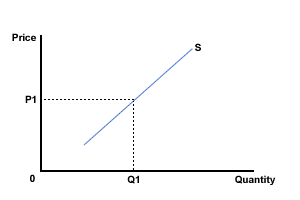Shifts and movements along of supply curve
Syllabus: Distinguish between movements along the supply curve and shifts of the supply curveDraw diagrams to show the difference between movements along the supply curve and shifts of the supply curve.
You must be absolutely certain about what causes shifts along or movements of a supply curve. Work carefully through the following example.
| Just to be very clear - while the following focuses on what determines the position of the supply curve on the graph in IB answers never use a supply curve on its own a graph showing the demand curve shifting position without the supply curve is meaningless you need both to say what happens to price and quantity and therefore make conclusions. |
Letīs Do Some
Economics
Example 1
The diagram below, Figure 1, represents the supply of a product (X) at a point in time. The price then was P1 and the quantity supplied Q1.

Figure 1 The supply of Product X
Copy this onto another piece of paper, then sketch on this new diagram the effect of the following changes. Treat each change as a separate change - in other words start each time from Figure 1. Once you have had a go at each one then follow the link below to check you got the change right.
(a) Market price of the product falls from P1 to P2. (Po)
Answer - part (a)
(b) The government passes new
minimum wage legislation, which will have the effect of increasing the
cost of labour to the firm (an increase in costs of production). (C)
Answer - part (b)
(c) The government places a tax on the sale of the product. (Tax)
Answer - part (c)
(d) A new and highly efficient production process has been developed for a good. (Tech)
Answer - part (d)
(e) Producers in a market can
easily produce two products - chocolate chip cookies and chocolate
coated cookies. The market for chocolate coated cookies has
considerably declined. Producers decide to supply more chocolate chip
cookies to the market instead. (Pz)
Answer - part (e)
These should not be difficult if you keep calm. Ask yourself three questions:
- Has a 'ceteris paribus' factor (or a non-price determinant of
supply other than the price of the good itself) changed? If the answer
is yes, then there is a shift of the whole curve.
- Will supply increase or decrease? This will determine if the
shift
is to the right or left - It can cause some people confusion if the
supply curve is seen as shifting its position upwards or downwards - if
the supply curve shifts downwards then supply has gone up (increased).
Say what???? Yes check it out on a diagram. Therefore you need to think
shift right (increase) and shift left (decrease) - with one exception
and that is to do with supply and tax because a tax on a good causes
the supply curve to shoft upwards by the amount of the tax.
- If the price has changed, will there be an extension (increase) or contraction (decrease) of demand?
